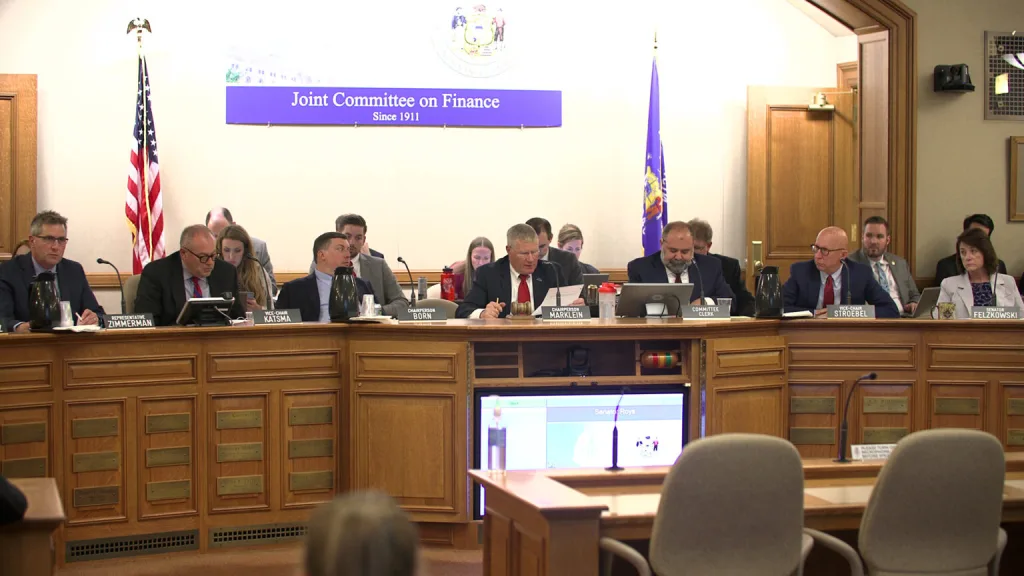How would you like a nice cold glass of cancer? How about a cup of hormone disruptions or abnormal fetal developments? While Governor Evers and members of the Joint Finance Committee point fingers and disagree on how to enforce new EPA water regulations, Wisconsinites continue to drink water contaminated with PFAS.

What are PFAS?
Colloquially known as forever chemicals, and often a part of microplastics, PFAS (Perfluoroalkyl and polyfluoroalkyl substances) are man-made and omnipresent. They have been detected in things like jackets, upholstery, carpets, non-stick pan coatings, cleansers, polishes, paints, and ski waxes. For more than 7 decades, these chemicals have infiltrated nearly everything in our environment, including plants, animals and fish. They are in us, too.
Why Are PFAS Bad For Us?
If you are wondering why PFAS are called “forever chemicals”, it’s because they are virtually indestructible and non-degradable. They are also extremely toxic at low levels (i.e. parts per quadrillion), posing significant risks to our health.
Recent research confirms the contribution of PFAS to disease and disability across the lifespan of humans. Some of these health risks are effects on the immune system (such as decreased vaccination response in infants and children), changes in liver function (such as higher cholesterol, elevated liver enzymes), the development of kidney cancer and low birth weight.
Pregnancy, PFAS and Disabilities

If you’re pregnant, low birth weight should be of particular concern to you.
Low birth weight is associated with long-term neurologic disability, cerebral palsy, impaired language development and impaired academic achievement. There is also an increased risk of chronic diseases including cardiovascular disease and diabetes.
PFAS have also been associated with miscarriage. For tips on staying safe during pregnancy, visit here.
Wisconsin’s Troublesome Areas
At least 45 percent of the nation’s tap water is estimated to have some type of PFAS, according to a study by the United States Geological Survey. That means nearly half of us might be consuming PFAS through our drinking water every day.
In Wisconsin, the towns and cities that have the highest levels of chemicals are Marinette and Peshtigo, Rhinelander, the Town of Campbell on French Island, Eau Claire, Wausau and Madison.
As for the city of Milwaukee, the highest levels of PFAS were found in private drinking wells along the borders of the Milwaukee International Airport. Waukesha also has a large number of wells with high levels of toxic “forever chemicals.”
Curious to know the level of PFAS in your water? The Wisconsin DNR has a DataViewer map that you can checkout.
How To Avoid PFAS
By now, you’re probably wondering if you should get rid of your non-stick pans and furniture polish. If your pans are damaged, then yes, throw them out. It’s also a good idea to reduce the number of household cleaners you use too, but what you really need to be concerned about, is the water you consume. While water used for cleaning dishes and taking showers poses little risk, the same can’t be said for the water you drink and use for cooking.
The main ways people can be exposed to PFAS include: Drinking contaminated municipal or private well water, eating fish with high levels of PFAS and eatating food grown or raised near places that used or made PFAS.
If you live in an area where the drinking water has tested high in PFAS, here are four things you can do to reduce your risk of exposure.
First, follow all public advisories regarding the consumption of water, fish and produce sourced in your area. In some cases, bottled water is safer than tap water.
Second, become familiar with the EPA’s new standard for the acceptable level of PFAS in our water. The EPA, has set the enforceable Maximum Contaminant Levels at 4.0 parts per trillion (PFOA and PFOS, individually). The current Wisconsin standard, implemented last year, is 70 parts per trillion but the state is now required to start implementing the new EPA standard. (This knowledge will help you to understand any progress in driving down contamination levels in your area.)
Third, if you have a well and want to test your water, you should contact your state environmental health agency (DHSEnvHealth@dhs.wisconsin.gov), for detailed advice or to obtain a list of state-certified laboratories using EPA-developed testing methods in drinking water. The National Environmental Laboratory Accreditation Management System website may also be helpful in finding a laboratory to test for PFAS.
Fourh, install an under-cabinet water filter certified to filter out PFAS. For a filter that can remove PFAS, look for one with the code NSF/ANSI 53 (or NSF/ANSI 58 for reverse osmosis systems), followed by the manufacturer’s claim that the product can remove PFAS.
For a list of other measures you can take, click here.
In The Mean Time

Why are Wisconsin legislators and the governor in a deadlock over the cleanup of these toxic chemicals? Republicans on the Joint Finance Committee, have taken steps towards remedial action, but they have concerns too. To address some of the cleanup costs, they put forth Senate Bill 312 which established a grant program of $125 million to assist municipalities and innocent landowners. Had it not been vetoed, the bill would have protected landowners from DNR enforcement if they did not cause the contamination.
Governor Tony Evers disagreed with this approach and felt that it dramatically scaled back regulators’ enforcement authority. He is of the opinion that it lets polluters off the hook for cleaning up their own contamination. He says it’s unfair to make Wisconsin taxpayers foot such bills.
Republicans responded by arguing that the DNR restrictions are designed to ensure the agency can’t fine or hold landowners liable for contamination that they didn’t cause. They have stressed that the bill doesn’t protect actual polluters. It should be noted that these same Republicans have also accused Evers of trying to create a slush fund.
Governor Evers had what seemed like the last word on this though — he vetoed the Bill last week. Then he turned around the next day and called for an emergency meeting with the Republicans to address the dangerous PFAS levels in Wisconsin’s water resources. Not one Republican showed up.
We Cannot Afford a Hopeless Deadlock
So here we are, at a stand still and what appears to be a stalemate. Each side has a valid concern, but our legislators need to move forward and compromise. Every day that we wait, is another day that people drink “forever chemicals” in Wisconsin. The risk of disease and disabilities for everyone, including the unborn, is unacceptable and morally reprehensible.
To voice an opinion to Governor Tony Evers, click here.
To contact the 2023-25 Joint Finance Committee, go here and click on the hyperlinks for each member.
J